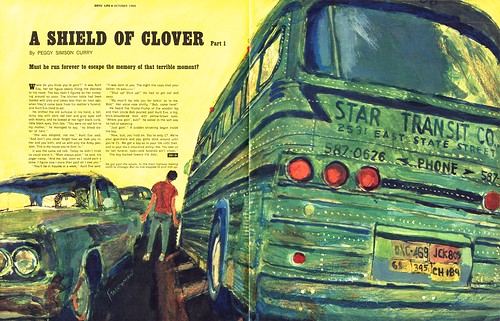
Still, its a little surprising that artwork like this had penetrated far enough into the popular culture that it was considered entirely appropriate for an audience quite a bit less sophisticated than that of , say, Fortune magazine or Esquire.

Marvin Friedman, born in 1930, had studied under Henry C. Pitz at the Philadelphia Museum School of Art before beginning a career in illustration that found him working for most of the major magazines in what Walt Reed, in his book, "The Illustrator in America", calls "a direct, reportorial manner."
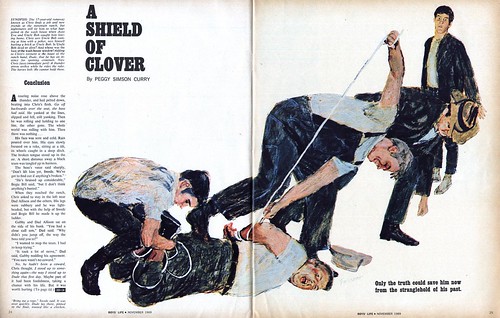
I would go one further and add, "with a heavy dose of vigorous, expressionistic influence".
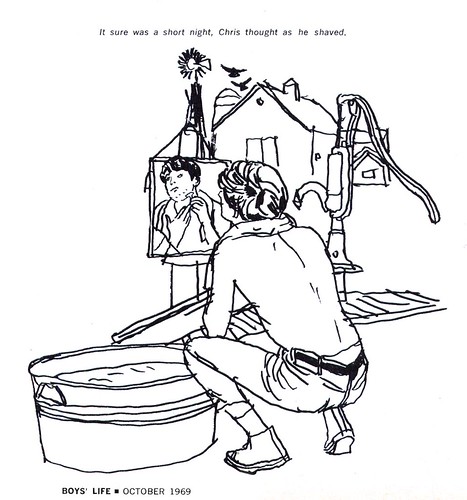
To me, Friedman's work is a good example of the middle ground between the radical fringe of Robert Weaver and the commercial acceptability of Bernie Fuchs or Bob Peak.

Not to put too fine a point on it but there is enough literal interpretation in Friedman's work here to make it more palatable to a general audience than there is in Weaver's art. But it still isn't as pretty or idealized as the work that Fuchs and many others from this period were producing.

The thing all of these artist had in common was that they were exploring ways to differentiate their work from that of the photographers who were capturing an ever growing share of the assignments. With that in mind a piece like the one below, which might initially be dismissed as looking like nothing more than the early stages of an underpainting, takes on a new light.
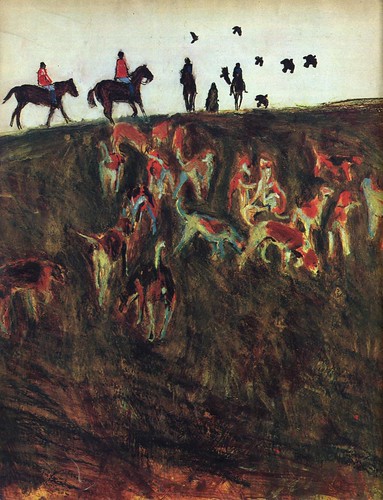
And this is the great contribution of the avant-garde movement: this first wave set illustrators free to explore their potential, to create the most honest work they could make and, hopefully, to enlighten and inspire art directors to see the merit in illustration as a still viable communications tool.
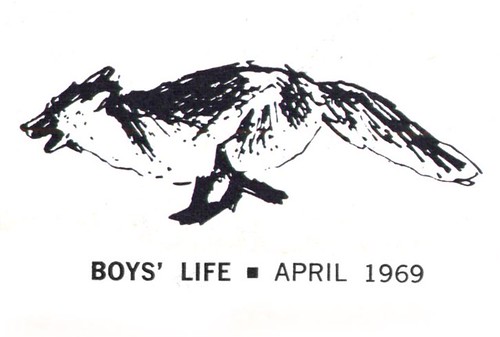
There is a wonderful collection of Marvin Friedman's later work at Marvin Friedman.net
The images can be viewed at a nice large size so you can better appreciate their complexity and detail.
My Marvin Friedman Flickr set.
I think of marvin friedman's work as domewhere between briggs & weaver. He has since the fifties done great line art. He did a lot of line spots for good housekeeping. Figures that looked as though they were drawn on the spot.
ReplyDeletei wish I knew the name of the Art Director of Boy's Life from this period. He selected great illustrators such as Friedman and gave them a pretty free hand. Parker was one of them.
ReplyDeleteWhat a week! (Including last Friday) I’ve enjoyed and learned so much the insightful analysis of you, Leif, and your readers. It’s interesting that you began with Fuchs, a few days later added the extreme of Weaver, then today we see Friedman. Much of Friedman’s reminded me, as it did Harald, of some of Briggs, especially his line quality. Many years ago, Bernie Fuchs name Al parker and Austin Briggs, in answer to a student’s query about illustrators who had most influenced him. Parker, of course for the obvious. Fuchs pointed out something I’ve never forgotten about Briggs; that he was one of the first to select that natural moment between extremes of an action, often an almost awkward moment. Friedman’s work has that same choice of gesture. Weaver’s later work has it to an extreme. Parker, too, selected wonderful natural gestures, gestures that rang true and so often those mere mortal illustrators couldn’t come up with. However, his were not awkward, unless they were appropriately so for the character.
Weaver’s originality of design, texture, and contrast knocks me out. The decline of his sight must have been affecting his priorities and the emphases in his work at this time. As for the figures, I can’t help agreeing with you, Leif. His earlier inimitable drawing of Marlene Dietrich in “the blue Angel” is as classic as Rene Bouche’s drawing of jack Benny. (Both have left indelible impressions on me. In fact, there is a resemblance in the freshness of line and spot-on essence of each character.) His former students do him proud.
Thanks again. Your analyses of trends looking back on the years, as well as Tom’s, has provided fascinating looking and reading.
Barbara
For all you illustrators and easel painters, have you ever done a sketch that was spontaneous, energetic and caught the jester perfectly?... and then could never quite duplicate it in your finish illustration or painting? It seemed to lack something... you know, it just didn't quite have that freedom that the preliminary sketch had. Well I think that's what Friedman and Weaver were trying to achieve... and maybe the way to do that, is NOT to do a finish from a sketch, but make the sketch your finish.
ReplyDeleteI pose the question, what is the criteria for a finished painting or illustration, anyway??!! Is it when it says what you want it to say or does it have to "look finished". We didn't solve that question 50 years ago, and we probably won't solve it today... but it's fun to kick it around.
One opinion on your query, Tom.
ReplyDeleteTheoretically, a painting is finished when it says what the artist wants it to say. ( I say theoretically because too often, when one wants to survive in FA, paintings are affected by the desires of gallery owners. ) An illustration is finished when it communicates what the client hopes it will and, ideally, in a way that is also personal to the illustrator.
How true your comment about preliminary sketches. "There was something about the rough"...the words an illustrator hates to hear. i stopped doing comps for that reason. I preferred a pencil sketch and a very rough color sketch. The longer I illustrated, the rougher my roughs got until they were almost mere blobs of color.
Barbara
Thank you so much for the postings on Friedman and Weaver, artists I'd never even heard of until I discovered them via your site.The drawing of both is just absolutely wonderful, and I find Friedman's later narrative works truly inspiring and influential.Keep up the excellent work on your site
ReplyDeletepaul ashley brown, bristol, england
Hello,
ReplyDeleteI am trying to reach Marvin Friedman, who was a good friend of my father's at the old Philadelphia Museum School of Art - they both took Henry Pitz's class.
My father, Bill Fleishell, an illustrator and graphic designer, just passed away this August 3rd , 2010.
Can someone please give Mr.Friedman my contact information? I have no idea where he is located but I know that my dad would want marvin to know what has happened. My dad always spoke highly of Marvin and they both were old school style illustrators.
Mr. Friedman- if this gets to you please call Will Fleishell studio at 202-544-6671 here in Washington DC